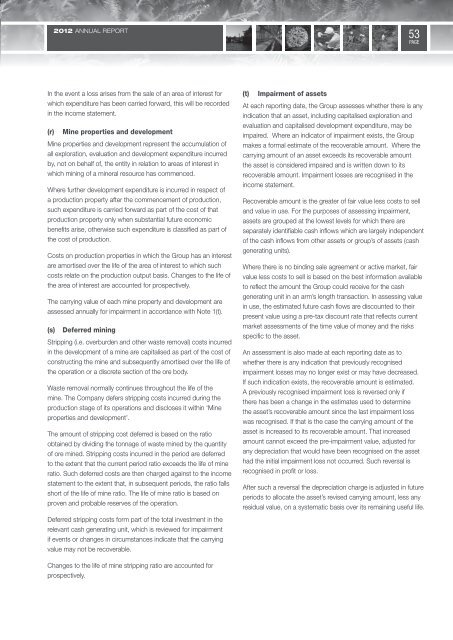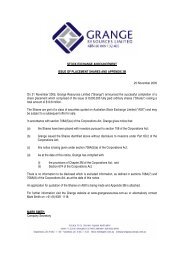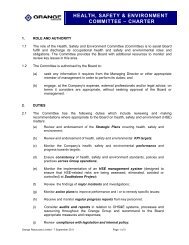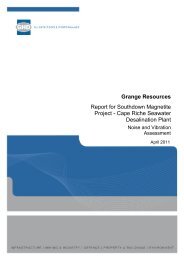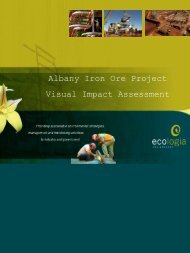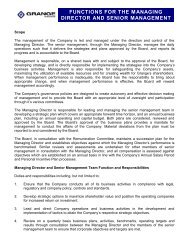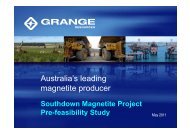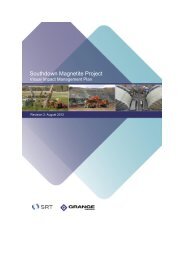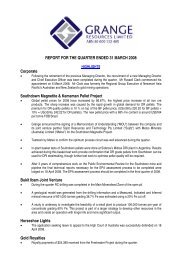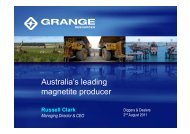2012 Annual Report (2 April 2013) - Grange Resources
2012 Annual Report (2 April 2013) - Grange Resources
2012 Annual Report (2 April 2013) - Grange Resources
Create successful ePaper yourself
Turn your PDF publications into a flip-book with our unique Google optimized e-Paper software.
<strong>2012</strong> ANNUAL REPORT<br />
53<br />
PAGE<br />
In the event a loss arises from the sale of an area of interest for<br />
which expenditure has been carried forward, this will be recorded<br />
in the income statement.<br />
(r) Mine properties and development<br />
Mine properties and development represent the accumulation of<br />
all exploration, evaluation and development expenditure incurred<br />
by, not on behalf of, the entity in relation to areas of interest in<br />
which mining of a mineral resource has commenced.<br />
Where further development expenditure is incurred in respect of<br />
a production property after the commencement of production,<br />
such expenditure is carried forward as part of the cost of that<br />
production property only when substantial future economic<br />
benefits arise, otherwise such expenditure is classified as part of<br />
the cost of production.<br />
Costs on production properties in which the Group has an interest<br />
are amortised over the life of the area of interest to which such<br />
costs relate on the production output basis. Changes to the life of<br />
the area of interest are accounted for prospectively.<br />
The carrying value of each mine property and development are<br />
assessed annually for impairment in accordance with Note 1(t).<br />
(s) Deferred mining<br />
Stripping (i.e. overburden and other waste removal) costs incurred<br />
in the development of a mine are capitalised as part of the cost of<br />
constructing the mine and subsequently amortised over the life of<br />
the operation or a discrete section of the ore body.<br />
Waste removal normally continues throughout the life of the<br />
mine. The Company defers stripping costs incurred during the<br />
production stage of its operations and discloses it within ‘Mine<br />
properties and development’.<br />
The amount of stripping cost deferred is based on the ratio<br />
obtained by dividing the tonnage of waste mined by the quantity<br />
of ore mined. Stripping costs incurred in the period are deferred<br />
to the extent that the current period ratio exceeds the life of mine<br />
ratio. Such deferred costs are then charged against to the income<br />
statement to the extent that, in subsequent periods, the ratio falls<br />
short of the life of mine ratio. The life of mine ratio is based on<br />
proven and probable reserves of the operation.<br />
Deferred stripping costs form part of the total investment in the<br />
relevant cash generating unit, which is reviewed for impairment<br />
if events or changes in circumstances indicate that the carrying<br />
value may not be recoverable.<br />
(t) Impairment of assets<br />
At each reporting date, the Group assesses whether there is any<br />
indication that an asset, including capitalised exploration and<br />
evaluation and capitalised development expenditure, may be<br />
impaired. Where an indicator of impairment exists, the Group<br />
makes a formal estimate of the recoverable amount. Where the<br />
carrying amount of an asset exceeds its recoverable amount<br />
the asset is considered impaired and is written down to its<br />
recoverable amount. Impairment losses are recognised in the<br />
income statement.<br />
Recoverable amount is the greater of fair value less costs to sell<br />
and value in use. For the purposes of assessing impairment,<br />
assets are grouped at the lowest levels for which there are<br />
separately identifiable cash inflows which are largely independent<br />
of the cash inflows from other assets or group’s of assets (cash<br />
generating units).<br />
Where there is no binding sale agreement or active market, fair<br />
value less costs to sell is based on the best information available<br />
to reflect the amount the Group could receive for the cash<br />
generating unit in an arm’s length transaction. In assessing value<br />
in use, the estimated future cash flows are discounted to their<br />
present value using a pre-tax discount rate that reflects current<br />
market assessments of the time value of money and the risks<br />
specific to the asset.<br />
An assessment is also made at each reporting date as to<br />
whether there is any indication that previously recognised<br />
impairment losses may no longer exist or may have decreased.<br />
If such indication exists, the recoverable amount is estimated.<br />
A previously recognised impairment loss is reversed only if<br />
there has been a change in the estimates used to determine<br />
the asset’s recoverable amount since the last impairment loss<br />
was recognised. If that is the case the carrying amount of the<br />
asset is increased to its recoverable amount. That increased<br />
amount cannot exceed the pre-impairment value, adjusted for<br />
any depreciation that would have been recognised on the asset<br />
had the initial impairment loss not occurred. Such reversal is<br />
recognised in profit or loss.<br />
After such a reversal the depreciation charge is adjusted in future<br />
periods to allocate the asset’s revised carrying amount, less any<br />
residual value, on a systematic basis over its remaining useful life.<br />
Changes to the life of mine stripping ratio are accounted for<br />
prospectively.


